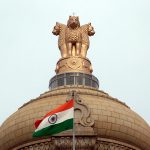Indian dance has four main styles:
- Bharatnatyam
- Kathak
- Kathakali
- Manipuri
- Bharatnatyam includes all dance and dance dramas based on the rules as laid down by the great sage Bharata in Natya Shastra.
- Dance dramas, namely Kuravanji, Bhagvata Mela, Kuchipudi and Solo dance Sadir belong to the realm of Bharatnatyam.
- It is Bharata Natya Sadir- solo dances- which is now known as Bharatnatyam.
- In a dance drama, many dancers participate wearing costumes and makeup. The dancer only has to play her own character.
- But in a solo performance Sadir, the dancer is a story teller.
- She has to act for all the characters of the story or the incident she is relating and there is nothing to help her except her own hand gestures, facial expressions and her own imaginative and artistic interpretation to express the ‘Bhava‘ in the story or the incident.
- Sadir is broadly divided into two categories:
- Nritta
- Nritya
- Natya element is indirectly there, unlike in dance-dramas wherein Natya is the main feature.
Nritta
- It is pure dance with no facial expressions.
- The movements have no specific meaning, and are done only to create beauty and aesthetic pleasure.
- Here Tala or rhythm aspect is more important.
- The dancer executes it with the feet.
- To attain this the artist has to undergo a very long, if not constant, physical penance.
- It is rather a bodily prayer offered to the Almighty.
Nritya
- It is dance with facial expressions and various movements, which have a definite meaning or an idea to convey.
- The dancer pours her very soul in each expression or movement, which is an outer mode of an intense and uplifting emotion.
- It demands maturity and sensitiveness of Heart.
- Nritya thus is a prayer of Heart.
Natya
- Natya, which has an additional element of drama, comes in indirectly.
- For though actual drama is not seen, one does feel that the dramatic element is prevalent, when the dancer, by her imaginative and intelligent interpretations, brings in some incidents to convey her ideas clearly. That is how she is a storyteller.
- Natya here demands imagination and intelligence and thus is a prayer of Mind.
Sadir, therefore, is a prayer of body-Nritta, Heart-Nritya and Mind- Natya.
Nritya and Natya have a perfect synchronization and thereby fall into one category which is known as Abhinaya.
Dance and Music
- It is rightly said that there can be no dance without music.
- Even an absolute dance like Tandava, which consists of footwork and various movements of Lord Shiva is performed to the accompaniment of pure rhythmical syllables sounded or sung on particular notes.
- If Bharatnatyam is to be rightly interpreted, it involves understanding-if not knowledge- of the Art Music.
- Anything which the dancer does is in perfect harmony with the musical composition.
- To suit the dance Nritta, pure dance, the music composed for it is also of the same type. Rhythm, which is full of intricate and yet fluent combination of beats, is really the main feature of this type of music.
It is brought in by means of exercises in notes (Tanas) practiced to attain high technique in music.
The musician has to undergo quite an amount of vocal “Sadhana” to attain perfection.
It is this type of music which is in perfect harmony with the pure dance Nritta.
2. To suit the dance Abhinaya (expressive dance), there is a selection of highly poetic musical piece based on a chosen Raga.
Every note of this musical piece is used to create the very emotion implied in poetry. The singer forgets himself and becomes one with it, thereby inspiring the dancer to be one with it.
Just as the dancer elaborates the emotion by using Natya element- some incidents- through application of her mind, the musician also elaborates intelligently the same thing through the development of the chosen Raga, which is a pleasant combination of classified Notes to bring about a particular emotion.
Thus for Abhinaya both the dancer and singer give an unreserved application of heart and mind. Such is the harmony of music and dance that even in music there is a prayer of body, heart and mind for Nritta, Nritya and Natya respectively.
- Bharata Natyam Sadir has its essentials in Bhava (facial expression), Raga (music which supports the dance) and Tala (rhythm).
- The very word Bharatnatyam gives clue to the essential elements Bhava, Raga and Tala, the harmonious blending of which gives the height of perfection to Bharatanatyam.
Thus Indian dance, in a nutshell, is a prayer of Body-Heart- Mind through Bhava, Raga and Tala to the Almighty Lord Divine.











